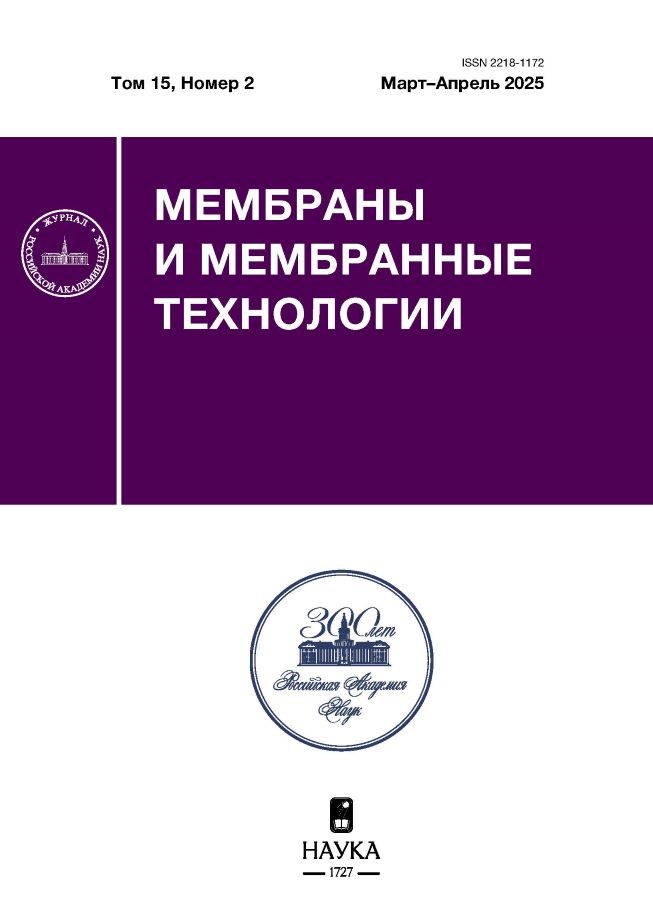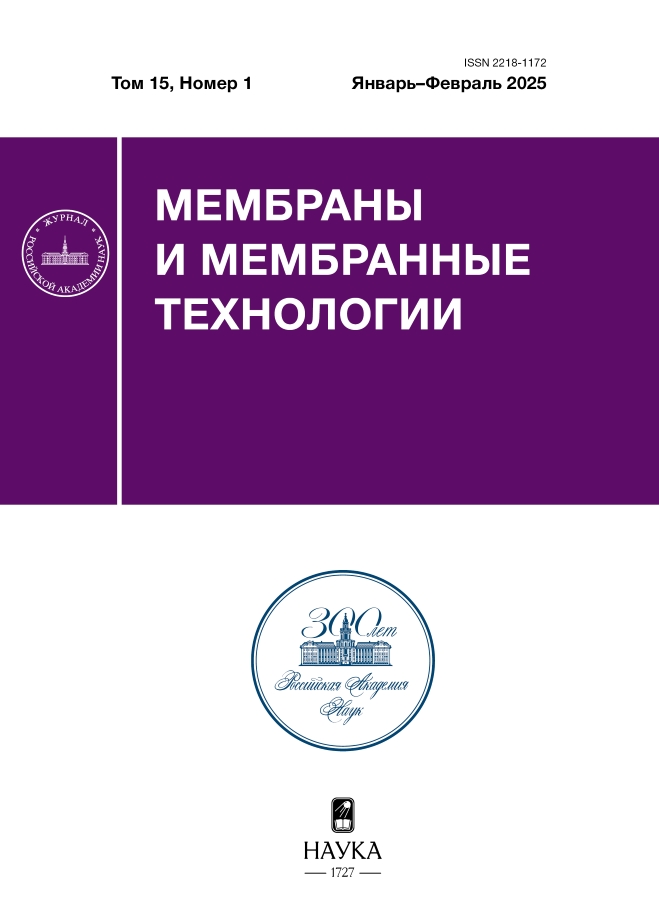Оценка ионной проводимости полиэлектролита с помощью метода молекулярной динамики
- Авторы: Ошеров П.М.1, Евщик Е.Ю.2,3, Шиховцева А.В.4, Файзуллин Р.З.5, Хамитов Э.М.6, Борисевич С.С.4
-
Учреждения:
- Институт интеллектуальных кибернетических систем Национального исследовательского ядерного университета «МИФИ»
- едеральный исследовательский центр проблем химической физики и медицинской химии РАН
- Московский физико-технический институт
- Федеральный исследовательский центр проблем химической физики и медицинской химии РАН
- Центр энергетических технологий, Сколковский институт науки и технологий, территория Инновационного центра «Сколково»
- Уфимский институт химии Уральского федерального исследовательского центра РАН
- Выпуск: Том 15, № 1 (2025)
- Страницы: 63-75
- Раздел: Статьи
- URL: https://ruspoj.com/2218-1172/article/view/685293
- DOI: https://doi.org/10.31857/S2218117225010051
- EDN: https://elibrary.ru/LANVWQ
- ID: 685293
Цитировать
Полный текст
Аннотация
В данной работе описана процедура разработки протокола теоретической оценки ионной проводимости двух полиэлектролитных систем, состоящих из олигомеров, имитирующих литиевую форму мембраны Нафион-115, пластифицированную в одном случае диметилсульфоксидом, в другом – пропиленкарбонатом. Модельные системы для теоретических расчетов были построены в соответствии со значениями степени набухания мембраны в указанных растворителях, определенными экспериментально. Протокол для молекулярно-динамических симуляций подобран с учетом особенностей строения и физико-химических свойств компонентов исследуемых систем. Анализ траекторий молекулярно-динамических симуляций включал оценку функций радиального распределения и коэффициентов самодиффузии. Для расчета ионной проводимости был использован авторский код, написанный на языке Python. Результаты теоретических расчетов находятся в согласии с экспериментальными данными. Предложенный в работе подход моделирования может быть использован для относительно быстрой оценки ионной проводимости в схожих электролитных системах в близком температурном интервале до границы фазового перехода.
Дополнительные материалы доступны в электронном виде по DOI статьи: 10.31857/S2218117225010051
Полный текст
Об авторах
П. М. Ошеров
Институт интеллектуальных кибернетических систем Национального исследовательского ядерного университета «МИФИ»
Email: liza@icp.ac.ru
Россия, Каширское ш., 31, Москва, 115409
Е. Ю. Евщик
едеральный исследовательский центр проблем химической физики и медицинской химии РАН; Московский физико-технический институт
Автор, ответственный за переписку.
Email: liza@icp.ac.ru
Россия, Проспект ак. Семенова, 1, г.о. Черноголовка, Московская область, 142432; Институтский пер., 9., Долгопрудный, Московская обл., 141701
А. В. Шиховцева
Федеральный исследовательский центр проблем химической физики и медицинской химии РАН
Email: liza@icp.ac.ru
Россия, Проспект ак. Семенова, 1, г.о. Черноголовка, Московская область, 142432
Р. З. Файзуллин
Центр энергетических технологий, Сколковский институт науки и технологий, территория Инновационного центра «Сколково»
Email: liza@icp.ac.ru
Россия, Большой бул., 30, стр. 1, Москва, 121205
Э. М. Хамитов
Уфимский институт химии Уральского федерального исследовательского центра РАН
Email: liza@icp.ac.ru
Россия, просп. Октября, 71, Уфа, Республика Башкортостан, 450054
С. С. Борисевич
Федеральный исследовательский центр проблем химической физики и медицинской химии РАН
Email: liza@icp.ac.ru
Россия, Проспект ак. Семенова, 1, г.о. Черноголовка, Московская область, 142432
Список литературы
- Yoo H.D., Markevich E., Salitra G., Sharon D., Aurbach D. // Mater. Today. 2014. V. 17. P. 110. doi: 10.1016/j.mattod.2014.02.014
- Ding Y., Cano Z.P., Yu A., Lu J., Chen Z. // Electrochem. Energy Rev. 2019. V. 2. P. 1. doi: 10.1007/s41918-018-0022-z
- Yoon J.H., Cho W.-J., Kang T.H., Lee M., Yi G.-R. // Macromol. Res. 2021. V. 29. P. 509. doi: 10.1007/s13233-021-9073-9
- Kinlen P.J., Heider J.E., Hubbard D.E. // Sensors Actuators B Chem. 1994. V. 22. P. 13. doi: 10.1016/0925-4005(94)01254-7
- Luo Q., Zhang H., Chen J., Qian P., Zhai Y. // J. Memb. Sci. 2008. V. 311. P. 98. doi: 10.1016/j.memsci.2007.11.055
- Xi J., Wu Z., Qiu X., Chen L. // J. Power Sources. 2007. V. 166. P. 531. doi: 10.1016/j.jpowsour.2007.01.069
- Kusoglu A., Weber A.Z. // Chem. Rev. 2017. V. 117. P. 987. doi: 10.1021/acs.chemrev.6b00159
- Sanginov E.A., Borisevich S.S., Kayumov R.R., Istomina A.S., Evshchik E.Y., Reznitskikh O.G., Yaroslavtseva T.V., Melnikova T.I., Dobrovolsky Y.A., Bushkova O.V. // Electrochim. Acta. 2021. V. 373. P. 137914. doi: 10.1016/j.electacta.2021.137914
- Yang L., Zeng J., Ding B., Xu C., Lee J.Y. // Adv. Mater. Interfaces. 2016. V. 3. P. 1600660. doi: 10.1002/admi.201600660
- Sanginov E.A., Evshchik E.Y., Kayumov R.R., Dobrovol’skii Y.A. // Russ. J. Electrochem. 2015. V. 51. P. 986. doi: 10.1134/S1023193515100122
- Sanginov E.A., Kayumov R.R., Shmygleva L.V., Lesnichaya V.A., Karelin A.I., Dobrovolsky Y.A. // Solid State Ionics. 2017. V. 300. P. 26. doi: 10.1016/j.ssi.2016.11.017
- Doyle M., Lewittes M.E., Roelofs M.G., Perusich S.A., Lowrey R.E. // J. Memb. Sci. 2001. V. 184. P. 257. doi: 10.1016/S0376-7388(00)00642-6
- Cui S., Liu J., Selvan M.E., Keffer D.J., Edwards B.J., Steele W.V. // J. Phys. Chem. B. 2007. V. 111. P. 2208. doi: 10.1021/jp066388n
- Zhou X., Chen Z., Delgado F., Brenner D., Srivastava R. // J. Electrochem. Soc. 2007. V. 154. P. B82. doi: 10.1149/1.2388735
- Vishnyakov A., Neimark A.V. // J. Phys. Chem. B. 2001. V. 105. P. 9586. doi: 10.1021/jp0102567
- Ohkubo T., Kidena K., Takimoto N., Ohira A. // J. Mol. Model. 2011. V. 17. P. 739. doi: 10.1007/s00894-010-0767-8
- Ohkubo T., Kidena K., Takimoto N., Ohira A. // J. Mol. Model. 2012. V. 18. P. 533. doi: 10.1007/s00894-011-1091-7
- Sun H., Yu M., Li Z., Almheiri S. // J. Chem. 2015. V. 2015. P. 169680. doi: 10.1155/2015/169680
- Jang S.S., Molinero V., Çaǧın T., Goddard W.A. // J. Phys. Chem. B. 2004. V. 108. P. 3149. doi: 10.1021/jp036842c
- Tse Y.-L.S., Herring A.M., Kim K., Voth G.A. // J. Phys. Chem. C. 2013. V. 117. P. 8079. doi: 10.1021/jp400693g
- Burlatsky S., Darling R.M., Novikov D., Atrazhev V.V., Sultanov V.I., Astakhova T.Y., Su L., Brushett F. // J. Electrochem. Soc. 2016. V. 163. P. A2232. doi: 10.1149/2.0461610jes
- Fong K.D., Self J., Diederichsen K.M., Wood B.M., McCloskey B.D., Persson K.A. // ACS Cent. Sci. 2019. V. 5. P. 1250. doi: 10.1021/acscentsci.9b00406
- Fong K.D., Self J., McCloskey B.D., Persson K.A. // Macromolecules. 2021. V. 54. P. 2575. doi: 10.1021/acs.macromol.0c02545
- Schrödinger Release 2021-2: Maestro, Schrödinger, LLC, New York, NY, 2021.
- Kayumov R.R., Shmygleva L.V., Evshchik E.Y., Sanginov E.A., Popov N.A., Bushkova O.V., Dobrovolsky Y.A. // Russ. J. Electrochem. 2021. V. 57. P. 911. doi: 10.1134/S1023193521060045
- Banks J.L., Beard H.S., Cao Y., Cho A.E., Damm W., Farid R., Felts A.K., Halgren T.A., Mainz D.T., Maple J.R., Murphy R., Philipp D.M., Repasky M.P., Zhang L.Y., Berne B.J., Friesner R.A., Gallicchio E., Levy R.M. // J. Comput. Chem. 2005. V. 26. P. 1752. doi: 10.1002/jcc.20292
- Leontyev I., Stuchebrukhov A. // Phys. Chem. Chem. Phys. 2011. V. 13. P. 2613. doi: 10.1039/c0cp01971b
- Blazquez S., Abascal J.L.F., Lagerweij J., Habibi P., Dey P., Vlugt T.J.H., Moultos O.A., Vega C. // J. Chem. Theory Comput. 2023. V. 19. P. 5380. doi: 10.1021/acs.jctc.3c00562 DOI K., Chikasako Y., Kawano S. // Fluid Dyn. Mater. Process. 2015. V. 11. doi: 10.3970/fdmp.2015.011.001
- Brandell D. // Polymer Electrolytes. Molecular dynamics simulations of Li ion and H-conduction in polymer electrolytes. Elsevier, 2010. P. 314–339. doi: 10.1533/9781845699772.1.314
- Raabe G. // Molecular Simulation Studies on Thermophysical Properties: With Application to Working Fluids. Maginn E., ed. Springer Singapore. Singapore, 2017.
- Shim Y. // Phys. Chem. Chem. Phys. 2018. V. 20. P. 28649. doi: 10.1039/c8cp05190a
- Rapaport D.C. // The Art of Molecular Dynamics Simulation. Cambridge University Press, 2004. doi: 10.1017/CBO9780511816581
- Maginn E.J., Messerly R.A., Carlson D.J., Roe D.R., Elliot J.R. // Living J. Comput. Mol. Sci. 2018. V. 1. P. 6324 doi: 10.33011/livecoms.1.1.6324
- Liu H., Maginn E. // J. Chem. Phys. 2011. V. 135. P. 124507
- doi: 10.1063/1.3643124
- Kumar G., Kartha T.R., Mallik B.S. // J. Phys. Chem. C. 2018. V. 122. P. 26315. doi: 10.1021/acs.jpcc.8b06581
- Sarangi S.S., Zhao W., Müller-Plathe F., Balasubramanian S. // ChemPhysChem. 2010. V. 11. P. 2001. doi: 10.1002/cphc.201000111
- France-Lanord A., Grossman J.C. // Phys. Rev. Lett. 2019. V. 122. P. 136001. doi: 10.1103/PhysRevLett.122.136001
- Del Pópolo M.G., Voth G.A. // J. Phys. Chem. B. 2004. V. 108. P. 1744. doi: 10.1021/jp0364699
- Kowsari M.H., Alavi S., Najafi B., Gholizadeh K., Dehghanpisheh E., Ranjbar F. // Phys. Chem. Chem. Phys. 2011. V. 13. P. 8826. doi: 10.1039/c0cp02581j https://github.com/OsherovPM/msd_E_for_ionic_conductivity
- Gebremichael Y., Schrøder T.B., Starr F.W., Glotzer S.C. // Phys. Rev. E. 2001. V. 64. P. 051503. doi: 10.1103/PhysRevE.64.051503
Дополнительные файлы

















